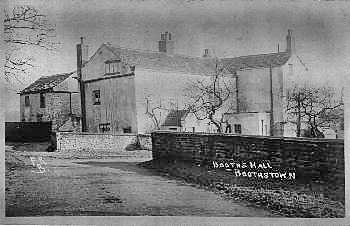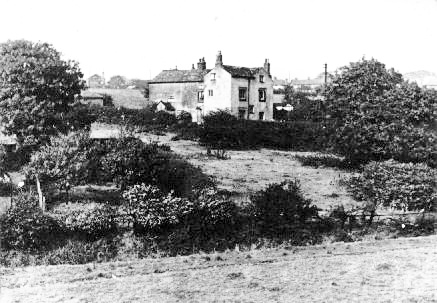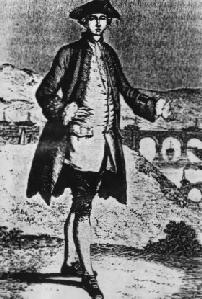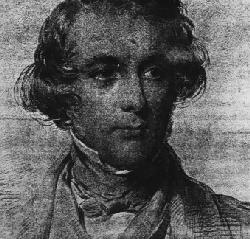Roman Legacy
The place we now know as Boothstown was once a tiny corner of the mighty Roman Empire. Evidence comes from the discovery of Roman coin hoards, first in 1947, and then in 1989. In 1947, George Bailey and Alfred Grundy, who were building a garden for canning factory workers at the Delph (just south of the East Lancashire Road, and just east of Mosley Common Road), found two earthenware pots containing beads and 540 coins minted between 251 and 275 AD. The coins, which originated in Gaul, became the property of the British Museum, though samples remained on display in the factory. The 1989 find of 3rd century coins was made by a bulldozer excavating for new housing at Booths Bank. They were hidden in a shallow hole, and although many had fused together over time, it is estimated that between 800 and 1000 coins were discovered. The coins are now in the possession of Salford’s museum, though each of the house-buyers on the site was given one as a memento.
The Roman road between Manchester and Wigan passes to the north of the village, where it was excavated in 1957. It lay just six inches below the soil, was thirteen feet wide, and had drainage ditches on each side. There is evidence that the road may have been constructed from stone from the local quarry at the delph in Boothstown, where the first coin hoard was found.
The Origins of Booths Estate in the Manor of Worsley
The origins of the Worsley manor are uncertain, and it is often incorrectly suggested that the manor was created by William I. In fact, the manor may have been established through the sub-division of the nearby Manor of Barton. The descent of the manor is usually traced to the time of William I, when Elias de Worsley, known as Gigas, the giant, was Lord of the Manor of Worsley. The family adopted the name of the local village of Workedlegh, or Worsley. Elias is said to have taken part in the crusades, and to have died at Rhodes.
On his death in 1299 the Lord of Worsley, Henry de Worsley, left a share of his property to his second son, Robert. The gift consisted of 500 acres of woodland (known as Mokens, and today called Malkin’s Wood) and 200 acres of pasture. The area of pasture was known as the Booths, from the name of the sheds or huts used by the local herdsmen, who protected the cattle and deer from the neighbouring Manor of Tyldesley. Other place names in Lancashire, notably in the Pendle area, were also derived from herdsmen’s booths, and reflect patterns of cultivation rather than long-established settlements: Barley Booth, Wheatley Booth, Roughlee Booth and Old Laund Booth. From the same derivation, there is a place called Boothtown near Halifax in West Yorkshire.
It is possible that Robert actually took possession of Booths around 1322, at the time of the remarriage of his mother, Margaret. Robert’s estate of Booths thus became an independent area within the Manor of Worsley, and Robert’s family line became known as the Worsleys of Booths. The family remained at Booths Hall until the 1590s. Although often referred to as the ‘Manor of Booths’, a distinct manor was not created, as Booths remained part of the Manor of Worsley, and subject to the Court Baron of Worsley. Other local halls also rose in prominence and were styled ‘manors’, their owners sometimes acquiring manorial rights, or rents, by purchase. As well as Booths, Shakerley Old Hall and Chaddock Hall became manors by reputation.
Chaddock
The hamlet of Chaddock was, in the middle ages, clustered round Chaddock Hall. It could have grown to become a distinct community, but its name yielded to that of Booths, and over time the neighbourhood became known as Boothstown. There is evidence of rivalry between the neighbours of Booths and Chaddock, with the Chaddock family accused of armed trespass and the theft of a stag from Booths Hall in 1547. Over time Chaddock declined as a place name, and now refers only to the site of Chaddock Hall (sadly destroyed in 2014) and the adjacent road.
The line of the Chaddock family ended with Grace Chaddock. After she married her second husband, Jacob Markland, the hall, its windmill and the two farms (Thomason’s and Oliver’s) were sold on 25 September 1731 to Samuel Clowes of Manchester. Some time after 1722, Samuel Clowes had purchased certain rents which were part of the lordship of Tyldesley, but which had earlier been assigned to Wardley then purchased by Francis Sherrington and later George Kenyon. These rents gave a manorial dignity to Chaddock. In 1810 Chaddock was sold at auction to Robert Haldane Bradshaw, and became later part of the Earl of Ellesmere’s Bridgewater Estate.
Old Booths Hall and the Worsleys of Booths
Around 1343, the original Booths Hall was built for Robert de Worsley; later additions to the hall survive today (it is now known as Wit’s End Cottage). The picture below shows the hall in 1910.

In 1402 the second Robert de Worsley of Booths died and was succeeded by his son Arthur. Arthur was in the care of guardians even as an adult. Despite this he married Elizabeth, daughter and heiress of Geoffrey de Worsley of Worsley and his second wife Isabella. As a result of the marriage, which took place when Elizabeth was only five years old, Arthur de Worsley of Booths claimed the Manor of Worsley. But Sir John Massey of Tatton (who had married Geoffrey’s sister, Alice) successfully claimed that Elizabeth was illegitimate, and that Alice was the rightful heir. Sir Geoffrey had also been heavily in debt to Massey. Thus, the Manor of Worsley passed to the Massey family, and the Booths estate remained separate from the manor. At the time of the marriage of Arthur and Elizabeth, Geoffrey may have envisaged reuniting Worsley and Booths.
Robert, son of Arthur, was succeeded by four more Roberts. The last Robert de Worsley of Booths succeeded his father, Sir Robert, in 1585, having earlier been in dispute with his father over the granting of land at Booths to the sons Sir Robert’s bigamous marriage to Margaret Beetham of Upholland. The last Robert Worsley of Booths had been appointed Keeper of the Fleet Prison in Salford in around 1580. The prison was for the incarceration and correction of Catholic priests and laity, and Robert was responsible for meeting certain costs of feeding and accommodating the prisoners, with the expense to be repaid by the prisoners themselves. It proved an onerous and financially draining responsibility for Robert, and his continuous pleas for financial assistance culminated in his request in 1586 to be relieved of his duties.
Probably because of his financial problems, Robert sold parts of his estate to Robert Hindley in 1582, and to a Francis Sherington (of Wigan, later of Wardley Hall) in 1587. Finally, in 1591, Robert Worsley sold Booths Hall and the rest of the estate for £1,400 to Robert Charnock, brother-in-law of Sherington.
It appears that the Worsleys did not leave Booths Hall quietly, with Robert allegedly involved in an occupation of the hall shortly afterwards. Then in 1605, a Gilbert Worsley, son of Robert, was said to have threatened and attacked the Charnocks resident in the hall.
The eldest son of the last Robert de Worsley of Booths was Thomas, who married Katherine, heiress of Keighley. Their grandson, also Thomas, married the heiress of Hovingham in Yorkshire; from this family is descended Lady Katherine Worsley, the present-day Duchess of Kent.
Pictured below is the old Booths Hall before the older parts of the house (on the left) were demolished in the early 20th century.

New Booths Hall and the Charnocks of Booths
Robert Charnock’s family home was Astley Hall, Chorley. Although the origins of the new hall at Booths are unknown, it is possible that it was built soon after 1610, when Robert Charnock’s second son, Thomas, married Bridget Molyneux of Sefton (a marriage above his station). Thomas occupied Booths Hall and inherited his father’s Chorley estates in 1616, but he had encountered financial difficulties, and by 1627 his property had been transferred to trustees. In around 1630 the Booths estate was acquired by Francis Sherington, a merchant and financier; it was among a number of local estates which he purchased around this time.
The Sheringtons of Booths
Booths Hall was occupied from around 1636 by Francis Sherington, and it appears that he prospered for a number of years as a financier to the gentry of the county. It was these connections that led to his difficulties following the Civil War of the 1640s, when Francis was involved in money-raising for the Royalist cause. This activity led to him being classified as a ‘deliquent’ by Parliament, the penalty for which was the seizure of estate income. Sherington’s problems were exacerbated by his Catholicism, and his status as a recusant. He was forced to swear allegiance to Parliament and was left to appeal for the restoration of his assets at a time when his financial status was perilous. Debt led to his imprisonment in 1653, where he was also required to swear an oath in renunciation of his Catholicism.
Around 1660, Francis Sherington attempted to make some money by exploiting coal outcrops on the Booths estate, and he transferred his Booths and Tyldesley estates to trustees for the benefit of his eldest son, John, who died in Lancaster prison in 1673. In 1677 Francis again placed his land in trust for the benefit of his sons. He died in 1681, whilst imprisoned at Lancaster. The Booths estate eventually fell to Francis’s third son, also Francis, and it was he who sold Booths in 1691 to Alexander Radcliffe, a textile merchant, before moving to Langscales near Garstang. At the time of the sale, the Sherington estate contained just 37 houses and 8 cottages.
The Clowes Family of Booths Hall
In 1721 John and Helen Radcliffe sold Booths Hall to Samuel Clowes, a Manchester merchant who bought much land and property in the area, including the Tyldesley Manor. In 1731 Samuel Clowes bought Chaddock Hall, and a Thomas Clowes purchased Garrett Hall. Samuel Clowes died on 5 August 1773, bequeathing Booths and Chaddock to his grandson, also Samuel. Today the ‘new’ Booths Hall has three gables, the central gable being the original.
Later Residents of Booths Hall
In 1861 Booths Hall was occupied by the family of Robert Lansdale (aged 51, described as a farmer), and other houses and cottages at Booths Hall were occupied by Mary Morley (39 and unmarried, a ‘fundholder’), the family of Thomas A. Morley (36, curate of Worsley), and the family of Henry Carr (53, described as a yeoman). It is not entirely clear from the 1861 census records which of these families occupied the new Booths Hall, the old Booths Hall, Booths Hall Farm or other properties on the estate.
In 1871 the census records five households at Booths Hall: Charles Spencer (55, curate of Worsley), Henry Carr (63, yeoman), James Littler (42, bank’s cashier), John Postle (23, collier) and Mary A. Evans (27, dressmaker).
In 1881 the Booths Hall properties were occupied by Robert Lansdale (71, agent [of the estate] and farmer, presumably at the new Hall), James Johnson (39, cotton spinner), John Wadsworth (53, farm labourer), William Oldfield (53, foreman of Boothstown coal wharf) and James Mann (32, a colliery labourer).
Messrs Lansdale, Wadsworth, Oldfield and Mann were still heads of household at the Booths Hall properties in 1891, along with John Deakin, a salesman of textiles.
In 1901 Booths Hall was occupied by the family of John Deakin (55, cotton manufacturer coloured goods), and Booths Hall Farm was occupied by George Cook (42, a gamekeeper). At other cottages and houses at Booths Hall were Ellis Marsh (at 510 Booth Hall Avenue, aged 37, a coal miner); George Body (at 512 Booth Hall Avenue, aged 31, a CE clergyman who lived with his sister, Una, aged 30, a parish nurse); and Joseph Oldfield (at 510 Booth Hall Avenue, aged 33, foreman at the coal wharf).
In 1911 the occupant of Booths Hall was Robert Bell, a 40-year old gamekeeper originally from Scotland. With Bell’s family were two assistant gamekeepers, also from Scotland.
The Canal Duke and the Bridgewater Trust
In 1720, Scroop Egerton, the Lord of the Manor of Worsley and 4th Earl of Bridgewater, was made 1st Duke of Bridgewater. His youngest son Francis Egerton (pictured below), who became the 3rd Duke at the age of twelve, was responsible for the building of the Bridgewater Canal, which served the local coal mining industry, and which is perhaps the defining feature of Worsley and Boothstown today. Although the Booths lands were not part of the Bridgewater Estate, the Duke had acquired considerable mineral rights in the Booths area.

In 1803 the Canal Duke died, and his will stated that his Worsley estate (and others) were to be placed into trust until twenty years after the death of all peers of the realm and their eldest sons. The trust was to benefit George Granville Leverson-Gower, 2nd Marquis of Stafford and later 1st Duke of Sutherland (son of Louisa, sister of the Canal Duke), upon whose death it would pass to his second son Francis. Francis duly inherited the revenues of the trust in 1833, whereupon he was obliged to change his name to Egerton under the terms of the inheritance.
Booths Estate and Worsley are Reunited
The first Superintendent of the Bridgewater Trust was Robert Haldane Bradshaw, who administered the estate, including the mines and the canal. In 1810, to develop the Trust’s mining interests, Bradshaw bought from Samuel Clowes (of Broughton Hall, but resident in Yorkshire) the estates of Booths and Chaddock, and other local land and property. He sold them to Lord Francis Egerton (pictured below, 1st Earl of Ellesmere from 1846), upon his retirement in 1834. The estate of Booths therefore became reunited with Worsley, although the wider Bridgewater estate was still held in trust. Newly acquired parts of the estate, such as Booths, were administered under the title of the Ellesmere Trust, until the 3rd Earl combined them with the Bridgewater Trust estate in 1900.

Francis Egerton initially had some difficulty imposing his presence on the administration of the estate due to the importance of the role of the superintendents. It was only in 1837 that Francis was able to appoint a superintendent of his choice and play the leading role in the management of the estate. The reduced monument to the 1st Earl of Ellesmere, who died in 1857, now stands behind the houses on the north side of Leigh Road to the east of Boothstown.
The End of Manorial Jurisdiction
Throughout the centuries the Manor of Worsley was the basis for local administration and government. The tradition of Walking the Bounds of the manor was carried on for generations. Before 1856, when Worsley Court House was built, the Court Leet and Court Baron of the manor were held in the Grapes Hotel in Worsley village, but on rare occasions at the Red Lion at Ellenbrook. It was the custom of the jurors of the court, once in every generation, to arrange for the boys (usually the apprentices of the estate) to be taught the boundary of the manor by walking its length, an undertaking which took two days. On those occasions a meeting of the court was held at the Red Lion, from where the walk began after breakfast.
By the end of the 19th century, the name of the village on local maps had evolved to ‘Boothstown’, from ‘Booths Town’ (or ‘Booth Town’). Manorial jurisdiction declined, and from 1884 the village was divided administratively by Stirrup Brook, with the west side lying in the Urban District Council of Tyldesley, and the east being part of the Urban District of Worsley. Previously the brook had divided the manors of Tyldesley and Worsley.
The End of the Trust and the Birth of Bridgewater Estates Ltd.
It was in 1903, after 100 years, that the Bridgewater Trust established by the will of the Canal Duke was wound up, and the estate passed into the ownership of the 3rd Earl of Ellesmere. Having struggled with death duties following the passing in 1914 of his father, John Francis Egerton, the 4th Earl of Ellesmere, sold the Worsley estates in 1923. The Bridgewater Estates company was thus formed by a consortium of local businessmen, whose prime economic interest lay in the estate’s vast mineral resources. The consortium was the idea of Jesse Wallwork, general supervisor of the Worsley estates and general manager of the collieries, who wished to see the estates kept together. Considerable financial backing was organised by businessman Joseph Ramsden, and the estate was sold by the Earl for some three million pounds. Bridgewater Estates was sold to Peel Holdings in 1983.
Modern Administration
Local government was reorganised in 1974, with the districts of Tyldesley and Worsley being incorporated into the new metropolitan authorities of Wigan and Salford respectively. Boothstown was thus still divided by Stirrup Brook. Both of the new local authorites were placed within the newly created administrative ‘county’ of Greater Manchester. Local boundaries were tidied up in 1994, and the whole of Boothstown south of the East Lancashire Road was placed in the City of Salford.
Acknowledgements
This web page was written by Tony Smith. General sources were Boothstown: A Chronological History by Carol Woodward, published by City of Salford Libraries and Information Service, Arts and Leisure Department, 1994, and Halls of the Manor of Worsley by C. Elsie Mullineux, 1989. Both booklets include bibliographies of historical sources. Further material was obtained from S. Smith’s history of the families of Booths Hall (1986), John Lunn’s History of Tyldesley (1953), and a local history information pack, provided by Walkden Library, and produced by local historians A. Monaghan, C.E. Mullineux and C.Woodward. Mrs Mullineux scrutinised the historical detail and kindly supplied information on the descent of the Worsley and Boothstown manors. Census information 1861 to 1911 was used to identify the residents of Booths Hall. The story of the Worsley estates is told in The Bridgewater Heritage by Christopher Grayling, Bridgewater Estates plc, 1983. ‘Booth’ place names are explained in The Origins of Lancashire by D. Kenyon, Manchester University Press, 1991. Historical photographs were kindly supplied by Walkden Library.